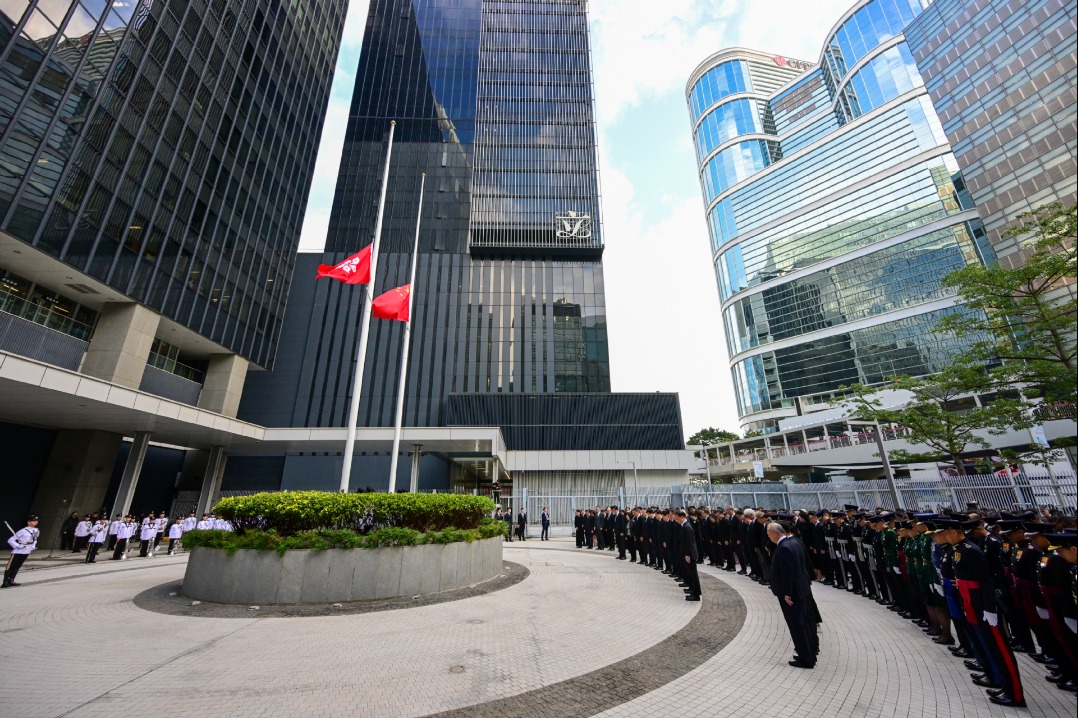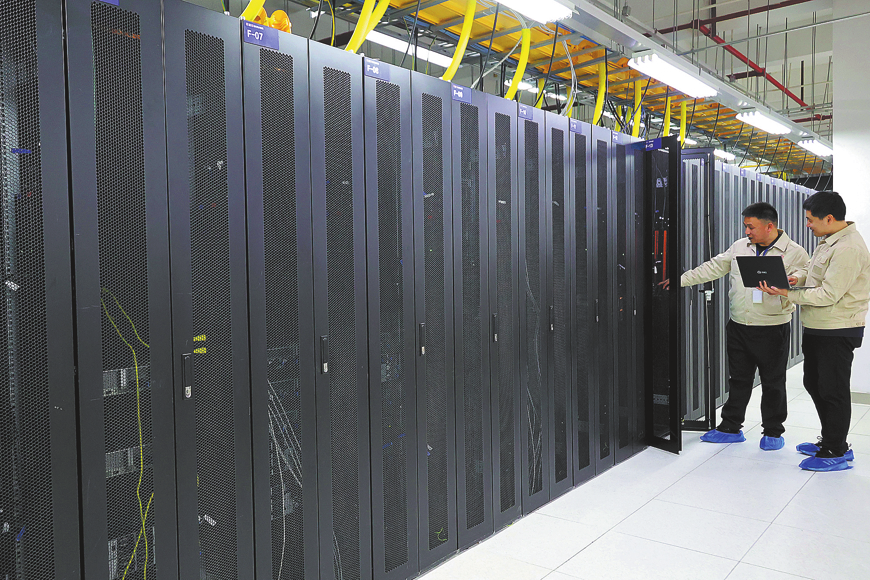Turning on the tap

| Niclas Wullt, general manager of Bluewater, demonstrates the effect of the water purifiers produced by the Swedish company. Provided to China Daily |
Bluewater looks to carve a niche with premium products in water purifier market
Unlike air purifiers, which are an integral part of many Chinese households, water purifiers are still relatively unknown products for most Chinese consumers. But that may soon change as growing concerns about water safety are prompting more Chinese consumers to turn to such products, creating a robust platform for overseas companies to showcase their products.
Bluewater, a Sweden-based water purifier maker, is one of the companies that is looking to make a mark in China with its top-end maximizer products that come with global quality assurances.
According to a recent study published by China Market Monitor, the size of the Chinese water purifier market was estimated to be about 9.5 billion yuan ($1.5 billion, 1.1 billion euros) last year. The study indicates that the market will grow by 80 percent this year.
But the real game-changer for most companies comes from reports that indicate that more than one-third of China's drinking water sources are polluted and unfit for consumption.
According to data published by the Chinese Center for Disease Control and Prevention, in 2011, only 61 percent of the water from major Chinese rivers was in category I to III, the desired level for safe drinking water. The report also pointed out that most of the pipes and other equipment used for transporting water in China are outdated and need urgent replacement.
"Guaranteeing proper water supply is still a major concern in most rural areas. But raising awareness about water quality is a new mission that we have to undertake seriously now," says Bai Xuetao, deputy director of the environment and heath department of the disease control and prevention center.
"Since smog is visible, people purchase air purifiers quickly. However, water pollution is hard to detect and there is not much awareness about the quality measures. People react only when there are reported instances of water pollution," he says.
In Europe and the US, more than 90 percent of the families have water purifying equipment installed at home, while in China it is less than 5 percent, says the China Market Monitor study.
"The space under the sink (where the water purifier is usually installed) in most families means big market potential for us," says Niclas Wullt, general manager of Bluewater, a brand owned by Blueblue AB, a privately-owned company in Sweden.
"Our studies have shown that most Chinese consumers will leave no stone unturned in their quest for clean, safe water. We are looking to fill that niche with our top-end water purifiers."
Explaining the brand preferences, Wullt says: "If (Chinese consumers) they like BMW, they buy the most expensive model with the best configuration. They have a similar attitude toward their kitchen also."
Though the maximizer was launched only last year in Sweden, its sister brand, the Blueair air purifier, is already a well-known product in the air purifier market.
Wullt says the entry-level Bluewater purifier costs 15,000 yuan while the top-end model "Bluewater Pro" costs 60,000 yuan. Most of the Chinese-made water purifiers are priced below 10,000 yuan, he says.
"Our target customers are the well-off customers who focus more on health, rather than the money, especially middle-class parents who want the best for their children," says Wullt. "If we can demonstrate that our products will make the difference, then it is not hard to sell them."
Looks also matter, he says, adding that unlike many other brands, the Bluewater purifiers look more like a compact box than bulky machines.
Most of the Chinese home appliance makers have already launched water purifiers. A report from consultancy firm AVC shows that domestic brands like Haier and Midea accounted for over 80 percent of the market last year. Another major foreign brand, A. O. Smith, said it sold about 140,000 water purifiers in China last year, and estimates the number to reach 220,000 this year.
Wullt says that Bluewater will not resort to price cuts or discounts to grow market share. Instead, he says, the company will bank on growing demand from high-end Chinese customers.
There are three major technology approaches for water purifier companies, he says. These are reverse osmosis, activated carbon and water softening technologies. Both Bluewater and A. O. Smith have adopted reverse osmosis technology, as studies indicate that it can filter 99 percent of the pollutants from tap water.
Water purifiers made with this technology account for 35 percent of the market, and have outperformed machines in other categories, says the China Market Monitor study.
The main advantage of the top-end Bluewater model is that it is more efficient, its makers say. While a regular purifier extracts one liter of purified water from five liters, the top-end model extracts one liter from 1.7 liters of water, Wullt says.
Bluewater will initially focus on Beijing and Shanghai before moving on to other Chinese cities, he says, adding that the company has 15 dealerships in Europe and five in the US.
The company is also in talks with high-end furniture chain stores in China to distribute its products and plans to team up with a top kitchen brand. Wullt declined to reveal any names, but indicated that 70 branches in Beijing and Shanghai would be enough to reach target customers.
Though the "Made in Sweden" tag gives the products quality assurance, it also raises the bar in terms of price due to high labor costs and expensive embedded logistics. Wullt says that the company can achieve cost reductions of more than 50 percent if it moves production to China.
"In the long run, the company needs to localize production by setting up at least one factory in China," he says. "The process is usually very quick, and it takes just a year to get the assembly line operating. China can meet most of our production requirements in the long run, but we will still need to import some components."
Apart from purified tap water and water for dishwashers, Bluewater is also targeting coffee shops and hospitals. "Usually hospitals have independent power and water purification systems. But in cases of emergencies, our water purifiers can serve as backup."
Several five-star hotels in Beijing have already expressed keen interest in the company's products, Wullt says.
Li Wei, deputy general manager of Zhejiang Qinyuan Water Purifier Co, a domestic water purifier maker, says Chinese brands are more aware of the water pollutants in various regions, and this gives them an advantage over foreign companies.
Wullt, however, rebuts this by saying that pollutants in water are more or less similar everywhere. "In most cases, the main purpose of the machine is to remove the various salts.
"Even in European countries, there are clean water issues. In Sweden, most of the pipes are those that were laid in the 1920s. So after nearly a century, there are pollutants from the ground and from the decayed pipes. In China, most of the pollutants are from industry. Our machines are able to get rid of 99 percent of the pollutants."
Instead of spending more money on commercials, Bluewater will look to promote its product through demonstrations in high-end furniture stores and premium kitchen stores. "Meter readings before using our products will show that the level of total dissolved solids is above 250 for tap water. The same will be less than 10 for water purified using our products," he says, adding that "testing is believing".
By providing good services and an effective maintenance chain, Bluewater can achieve double-digit growth every year, Wullt says.
Contact the writers through wangchao@chinadaily.com.cn
(China Daily European Weekly 05/23/2014 page20)
Today's Top News
- Takaichi must stop rubbing salt in wounds, retract Taiwan remarks
- Millions vie for civil service jobs
- Chinese landmark trade corridor handles over 5m TEUs
- China holds first national civil service exam since raising eligibility age cap
- Xi's article on CPC self-reform to be published
- Xi stresses improving long-term mechanisms for cyberspace governance































